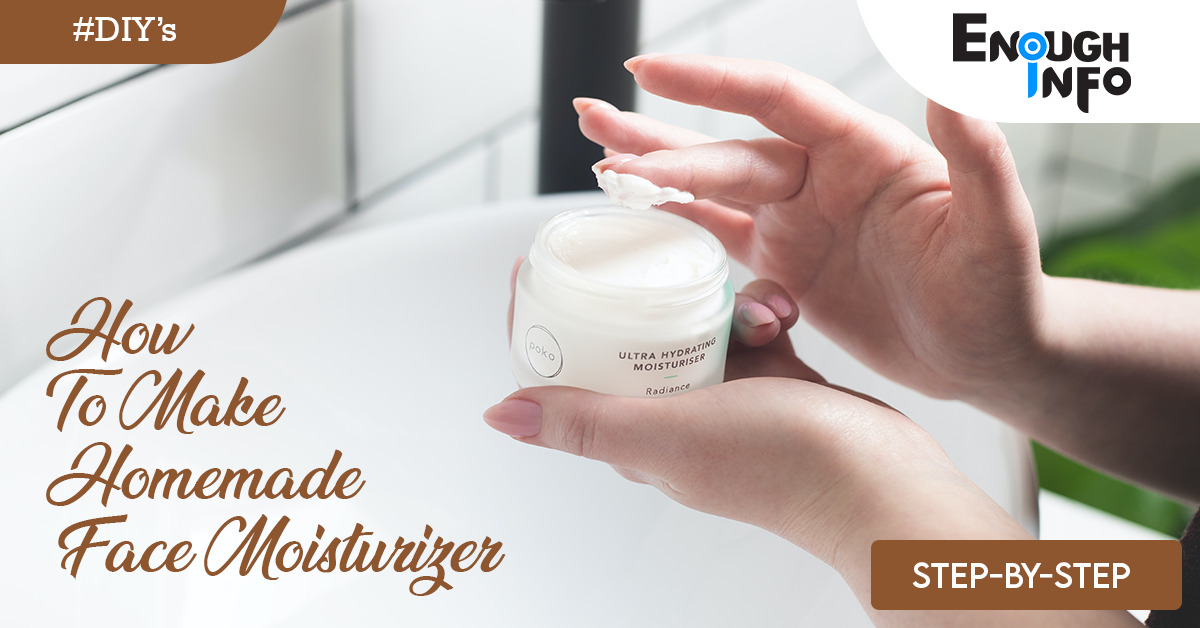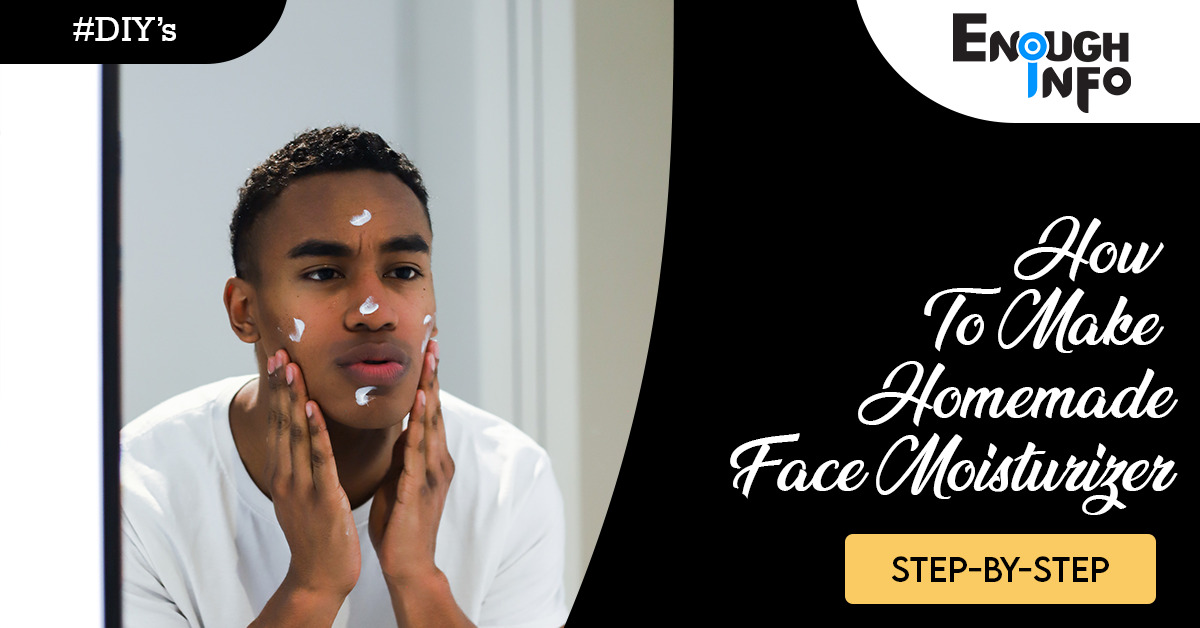How To Make Homemade Face Moisturizer

How To Make Homemade Face Moisturizer: When it comes to skincare, moisturizing is a crucial step that helps nourish and hydrate the skin, keeping it soft, supple, and healthy.While there are several commercial facial moisturisers, creating your own lets you customise the ingredients to your skin type and preferences. EnoughInfo.com

Making homemade face moisturizer offers numerous benefits that go beyond just skincare. It allows you to have control over the ingredients, customize the formulation to suit your skin type, choose natural and healthier options, save money, reduce waste, and unleash your creativity. By investing time and effort in creating your own moisturizer, you can elevate your skincare routine and achieve healthier, happier skin.
Taking care of your skin is an essential part of maintaining its health and appearance. Moisturizing plays a crucial role in keeping your skin hydrated, nourished, and protected. While there are numerous commercial face moisturizers available on the market, making your own homemade face moisturizer offers several important benefits. Let’s explore why creating your own face moisturizer is important: How To Make Homemade Body Scrub
Read Also: 11 Ways To Gain Healthy Weight Fast Naturally(2023 Guide)
Benefits of Homemade Face Moisturizer
1. Control over Ingredients:
One of the primary reasons to make homemade face moisturizer is the ability to have complete control over the ingredients used. Commercial moisturizers often contain synthetic chemicals, artificial fragrances, and potentially harmful additives. By making your own moisturizer, you can carefully select natural and organic ingredients that suit your specific skin type and address your unique concerns. You have the power to choose nourishing oils, soothing agents, and active compounds that will benefit your skin without exposing it to unnecessary toxins.
2. Customization for Your Skin Type:
Everyone’s skin is different, and what works for one person may not work for another. Homemade face moisturizer allows you to tailor the formulation to your specific skin type and needs. Whether you have dry skin, oily skin, sensitive skin, or a combination of different skin types, you can adapt the ingredients and ratios to create a moisturizer that perfectly suits your skin’s requirements. This customization ensures that your moisturizer effectively hydrates, nourishes, and balances your skin, promoting a healthy and radiant complexion.
3. Natural and Healthier Options:
Many commercial face moisturizers contain synthetic ingredients and harsh chemicals that can potentially irritate the skin or cause allergic reactions. By making your own face moisturizer, you can opt for natural and organic ingredients that are gentle and beneficial for the skin. Natural oils, plant extracts, and other botanical ingredients provide vitamins, antioxidants, and essential fatty acids that promote skin health. Homemade moisturizers are free from harmful additives, such as parabens, sulfates, and artificial fragrances, which may have long-term negative effects on your skin and overall health. How To Do A Basic Skincare Routine
4. Cost-Effectiveness:
Creating your own homemade face moisturizer can be cost-effective compared to purchasing high-end commercial products. Many of the ingredients used in homemade moisturizers are readily available and affordable. Additionally, the same ingredients can be used in multiple DIY skincare recipes, allowing you to make the most of your investment. You can also adjust the quantity of ingredients according to your needs, preventing wastage and saving money in the long run.
5. Eco-Friendly and Sustainable:
Another significant advantage of homemade face moisturizer is its positive impact on the environment. Commercial skincare products often come in excessive packaging, contributing to plastic waste and environmental pollution. By making your own moisturizer, you can use reusable containers and minimize your carbon footprint. Additionally, opting for natural and organic ingredients promotes sustainability and supports eco-friendly practices.
6. Empowerment and Creativity:
Making your own face moisturizer empowers you to take control of your skincare routine and make conscious choices about what you put on your skin. It allows you to become more aware of the ingredients and their benefits, fostering a deeper connection with your skincare regimen. Creating your own skincare products can also be a creative and fulfilling experience. You can experiment with different ingredients, textures, and scents to find the perfect formulation for your skin. This creative aspect adds a sense of personalization and enjoyment to your skincare routine.
Read Also: 22 Top Foods For Promoting Heart Health(All You Need to Know)
How to Make Homemade Face Moisturizer: A Complete Guide
In this comprehensive guide, we will explore the benefits of homemade face moisturizers, the key ingredients to use, and step-by-step instructions to create your very own moisturizer. So let’s dive in!
Choosing the Right Ingredients:
Before we delve into the recipes, let’s explore some key ingredients commonly used in homemade face moisturizers:
Carrier Oils:
Carrier oils form the base of the moisturizer and provide essential hydration to the skin. Here are some popular carrier oils suitable for different skin types:
- Jojoba Oil: Suitable for all skin types, jojoba oil closely resembles the skin’s natural sebum, making it highly moisturizing and balancing.
- Sweet Almond Oil: Ideal for dry and sensitive skin, sweet almond oil is rich in fatty acids and vitamins that nourish and soothe the skin.
- Coconut Oil: Best for normal to dry skin, coconut oil is deeply moisturizing and possesses antimicrobial properties.
- Argan Oil: Suitable for all skin types, argan oil is packed with antioxidants and essential fatty acids, providing hydration and promoting elasticity.
Humectants:
Humectants help attract moisture to the skin and maintain hydration levels. Some common humectants used in face moisturizers include: How To Create A DIY Home Renovation Plan
- Glycerin: Glycerin is a natural humectant that draws moisture to the skin, keeping it hydrated and plump.
- Aloe Vera Gel: Aloe vera is not only soothing but also acts as a humectant, locking in moisture and promoting skin elasticity.
- Hyaluronic Acid: Hyaluronic acid is a powerful humectant that can hold up to 1000 times its weight in water, providing intense hydration and reducing the appearance of fine lines and wrinkles.
Essential Oils:
Essential oils can be added to provide additional benefits and fragrance to your homemade face moisturizer. However, it’s important to note that essential oils are highly concentrated and should be used sparingly. Some popular essential oils for skin care include:
- Lavender: Lavender essential oil has calming properties and promotes relaxation. It is also known for its skin-soothing effects.
- Tea Tree: Tea tree essential oil possesses antimicrobial properties, making it suitable for acne-prone or oily skin.
- Rosehip: Rosehip essential oil is rich in antioxidants and helps improve skin tone, reduce scars, and promote a youthful complexion.
Read Also: How To Make Homemade Natural Cleaning Products
Homemade Face Moisturizer Recipes:

Now that you are familiar with the key ingredients, let’s explore a few simple yet effective homemade face moisturizer recipes:
Basic DIY Face Moisturizer:
Ingredients:
- 2 tablespoons of carrier oil (such as jojoba oil, sweet almond oil, or coconut oil)
- 1 tablespoon of shea butter
- 1 teaspoon of beeswax pellets
- 5-10 drops of your favorite essential oil (optional)
Instructions:
- In a double boiler or a heatproof bowl placed over a pot of simmering water, melt the shea butter and beeswax pellets until fully melted and combined. How To Organize A Pantry(The Ultimate Guide)
- Remove from heat and let the mixture cool slightly.
- Stir in the carrier oil and essential oil (if using) until well blended.
- Pour the mixture into a clean, airtight jar or container.
- Allow the moisturizer to cool and solidify before use.
Nourishing Avocado and Honey Moisturizer:
Ingredients:
- 1 ripe avocado
- 1 tablespoon of honey
- 1 tablespoon of aloe vera gel
- 1 teaspoon of almond oil
Instructions:
- Mash the avocado in a bowl until smooth and creamy.
- Add the honey, aloe vera gel, and almond oil to the mashed avocado.
- Mix well until all the ingredients are thoroughly combined.
- Transfer the mixture into a clean, airtight container.
- Apply a small amount to your face and neck, gently massaging it into the skin. Leave it on for 10-15 minutes, then rinse with warm water.
Soothing Aloe Vera and Coconut Oil Moisturizer:
Ingredients:
- 2 tablespoons of aloe vera gel
- 1 tablespoon of coconut oil
- 1 teaspoon of vitamin E oil
- 5-10 drops of lavender essential oil (optional)
Instructions:
- In a small bowl, combine the aloe vera gel, coconut oil, vitamin E oil, and lavender essential oil (if using). How To Organize A Pantry(The Ultimate Guide)
- Mix well until the ingredients are thoroughly blended.
- Transfer the mixture to a clean, airtight container.
- Apply a small amount to your face and neck, gently massaging it into the skin until fully absorbed.
Rejuvenating Green Tea and Jojoba Oil Moisturizer:
Ingredients:
- 1 cup of brewed green tea, cooled
- 1 tablespoon of jojoba oil
- 1 tablespoon of shea butter
- 1 teaspoon of vegetable glycerin
Instructions:
- Brew a cup of green tea and allow it to cool completely.
- In a heatproof bowl, melt the shea butter using a double boiler or by placing the bowl over a pot of simmering water.
- Remove the melted shea butter from the heat and let it cool slightly.
- Add the jojoba oil and vegetable glycerin to the melted shea butter, and mix well.
- Slowly pour the cooled green tea into the mixture, stirring continuously until all the ingredients are well combined.
- Transfer the moisturizer to a clean, airtight container.
- Apply a small amount to your face and neck, gently massaging it into the skin until absorbed.
Read Also: How To Make Homemade Bread(Step By Step)
FAQs & Answers on How To Make Homemade Face Moisturizer
1. Can I use homemade face moisturizers on all skin types?
Yes, homemade face moisturizers can be customized to suit different skin types. You can adjust the ingredients based on your specific needs. However, it’s always recommended to do a patch test before applying any new product to your face.
2. How long does homemade face moisturizer last?
The shelf life of homemade face moisturizers can vary depending on the ingredients used. Generally, they can last for several weeks to a few months if stored in a cool, dry place and in airtight containers. However, it’s advisable to make small batches and use them within a reasonable timeframe to ensure freshness and efficacy.
3. Are homemade face moisturizers as effective as commercial ones?
Homemade face moisturizers can be just as effective as commercial ones, if not more. By using high-quality, natural ingredients, you can provide your skin with nourishment and hydration. However, the effectiveness may vary depending on individual skin types and specific concerns.
4. Can I add essential oils to my homemade face moisturizer?
Yes, you can add essential oils to your homemade face moisturizer for their added benefits and fragrance. However, it’s important to use them sparingly and choose oils that are safe for skin care. Always dilute essential oils properly and perform a patch test to ensure you don’t have any adverse reactions. How To Make A Vegetarian Meal(The Ultimate Guide)
5. How often should I apply homemade face moisturizer?
You can apply homemade face moisturizer twice a day, in the morning and evening, after cleansing your face. Adjust the frequency based on your skin’s needs and personal preference.
6. Can I use homemade face moisturizer as a night cream?
Yes, you can use homemade face moisturizer as a night cream. The nourishing and hydrating properties of the moisturizer can help replenish your skin while you sleep. However, you may choose to make a slightly richer version specifically for nighttime use.
Read Also: How to make homemade ice cream without an ice cream Maker
Conclusion:
Creating your own homemade face moisturizer allows you to take control of your skincare routine, customize the ingredients to suit your skin type, and promote healthier, more radiant skin. By using natural and nourishing ingredients, you can provide your skin with hydration, nutrients, and protection without the use of harsh chemicals. Experiment with different recipes, adapt them to your specific needs and enjoy the benefits of a personalized skincare experience. Remember to patch-test new ingredients and products and consult a dermatologist if you have any specific skin concerns or conditions. Embrace the joy of homemade skincare and unlock the natural beauty within you.
Recommended;
How To Make A DIY Face Mask For Oily Skin
How to Get Rid of Body Odor(2023)
11 Benefits of Organic Skincare for Sensitive Skin




